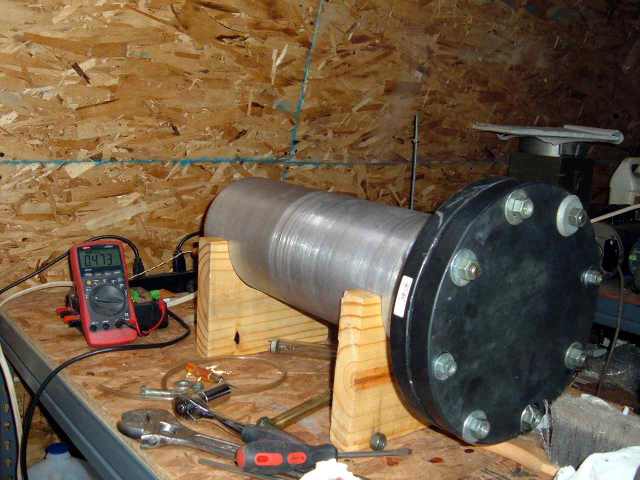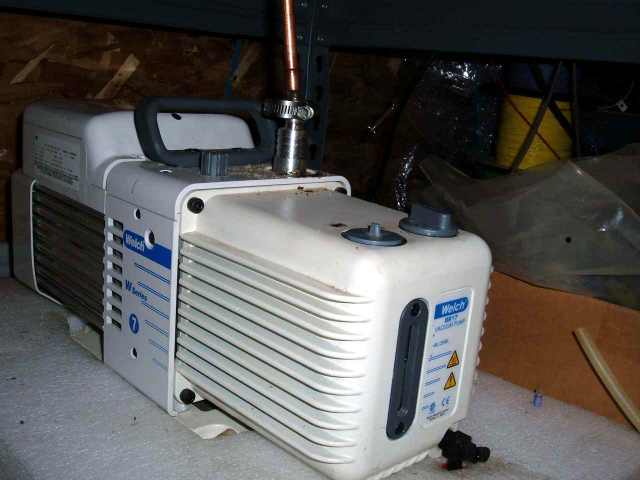 I'd really wanted to do the standard bell jar thing, and may yet.
Everyone around here really objected to my idea of using cut off
3 liter wine bottles as unsafe. Who knows? Haven't tried that
yet, though I have plenty of cut–off bottles. I think with the
right baseplate to take inward stress off the bottle base, it would work.
I'd really wanted to do the standard bell jar thing, and may yet.
Everyone around here really objected to my idea of using cut off
3 liter wine bottles as unsafe. Who knows? Haven't tried that
yet, though I have plenty of cut–off bottles. I think with the
right baseplate to take inward stress off the bottle base, it would work.At any rate, here is what I did do. This is made from a fire extinguisher. I cut it off in the lathe, then welded a pipe flange from McMaster-Carr on there. It leaked a little after the first pass, so I welded it again. Dang, those flanges are heavy – that is 1" steel there. Getting the door to reseal is currently a problem. I'm using a gasket I made from Viton sheet, also a McMaster item. It seems one cat hair in there is enough to mess things up. Gotta go get a real torque wrench too as it's possible to induce a leak by over–tightening one bolt in relation to the others. Once that source of leaks is handled, I will start with other penetrations of the basic chamber. I will use WWII era metal vacuum tubes for getting wires in and out. They cut easily with a tubing cutter. The meter is reading the pirani gage we built at .473 volt. At atmospheric it reads about 3.5 volts. The bulb sees half of that. That's not quite the best vacuum we've had, this was probably done while waiting for it to leak to atmospheric again so it could be opened. The next hole I put in was for a tiny, all metal needle valve so I wouldn't have to wait so long. The first time it took days to leak back up enough to open! Obviously, this thing needs a window too. I got a quartz window at McMaster for it, but one thing at a time.
 Here is the pump we bought from McMaster by spec without even checking
who made it. They chose alright, it is a very nice one, which unlike
the surplus ones I have, does NOT backstream oil when turned off.
I'd wanted to do an all–metal construction, but looking at that
fitting changed my mind. It has the intake filter and check valve in
it, so machining on it is a no–no. So there is one little
1/4" piece of Viton pipe in there doing the connection. Hope that
will work out well enough. It does help with vibration. This pump has
another nice property. It's quiet when not moving lots of air, and
doesn't draw anything like the nameplate power once you have a decent
vacuum. Something on the order of 250 watts for a 1/2 hp motor.
Even so, we will automate this to run only as needed, using the pirani
gage for a control source. This pump cost something like $2600
at McMaster, their number: 8460K72. Ouch! But, we now have a
for–real pump, with low vapor pressure oil that's never seen water or
anything else nasty. We can now use the surplus other pumps for
doing vacuum impregnation, freeze drying and suchlike things that
aren't too good for a good pump.
Here is the pump we bought from McMaster by spec without even checking
who made it. They chose alright, it is a very nice one, which unlike
the surplus ones I have, does NOT backstream oil when turned off.
I'd wanted to do an all–metal construction, but looking at that
fitting changed my mind. It has the intake filter and check valve in
it, so machining on it is a no–no. So there is one little
1/4" piece of Viton pipe in there doing the connection. Hope that
will work out well enough. It does help with vibration. This pump has
another nice property. It's quiet when not moving lots of air, and
doesn't draw anything like the nameplate power once you have a decent
vacuum. Something on the order of 250 watts for a 1/2 hp motor.
Even so, we will automate this to run only as needed, using the pirani
gage for a control source. This pump cost something like $2600
at McMaster, their number: 8460K72. Ouch! But, we now have a
for–real pump, with low vapor pressure oil that's never seen water or
anything else nasty. We can now use the surplus other pumps for
doing vacuum impregnation, freeze drying and suchlike things that
aren't too good for a good pump.